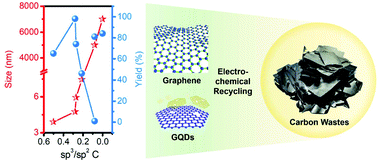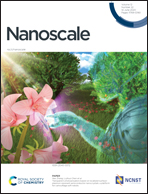A polyimide-pyrolyzed carbon waste approach for the scalable and controlled electrochemical preparation of size-tunable graphene†
Abstract
Carbon materials are widely used in numerous fields, thus changing our lives. With the increasing consumption of carbon-based products, the disposal of consequent wastes has become a challenge due to their inert nature, which is hard to degrade, burn, or melt. Here, a recyclable strategy is proposed to deal with the explosive growth of carbon wastes. Through a fast and clean electrochemical method, carbon wastes are converted into functional building blocks of high value, such as graphene and graphene quantum dots (GQDs). For typical polyimide-pyrolyzed carbon (PPC), we establish the relationship between the chemical structure of raw materials and the characteristics of graphene products, including size and yield. The size-tunable graphene ranging from 3 nm to tens of micrometers is prepared by tuning the sp3/sp2 carbon ratio of PPC from 0.5 to 0 at adjustable temperatures (800 °C–2800 °C). Significantly, PPC with a bicontinuous structure (comprising sp2 and sp3) was efficiently cut into GQDs in 2 h with a high yield of 98%. Our protocol offers great potential for the scale-up preparations and applications of GQDs. Besides, we demonstrate that the GQDs performed well as dispersants to disperse hydrophobic carbon nanotubes (0.6 mg mL−1) in water and improved the gravimetric capacitance of graphene-based supercapacitors by 79.4% with 3% GQDs added as nano-fillers.



 Please wait while we load your content...
Please wait while we load your content...